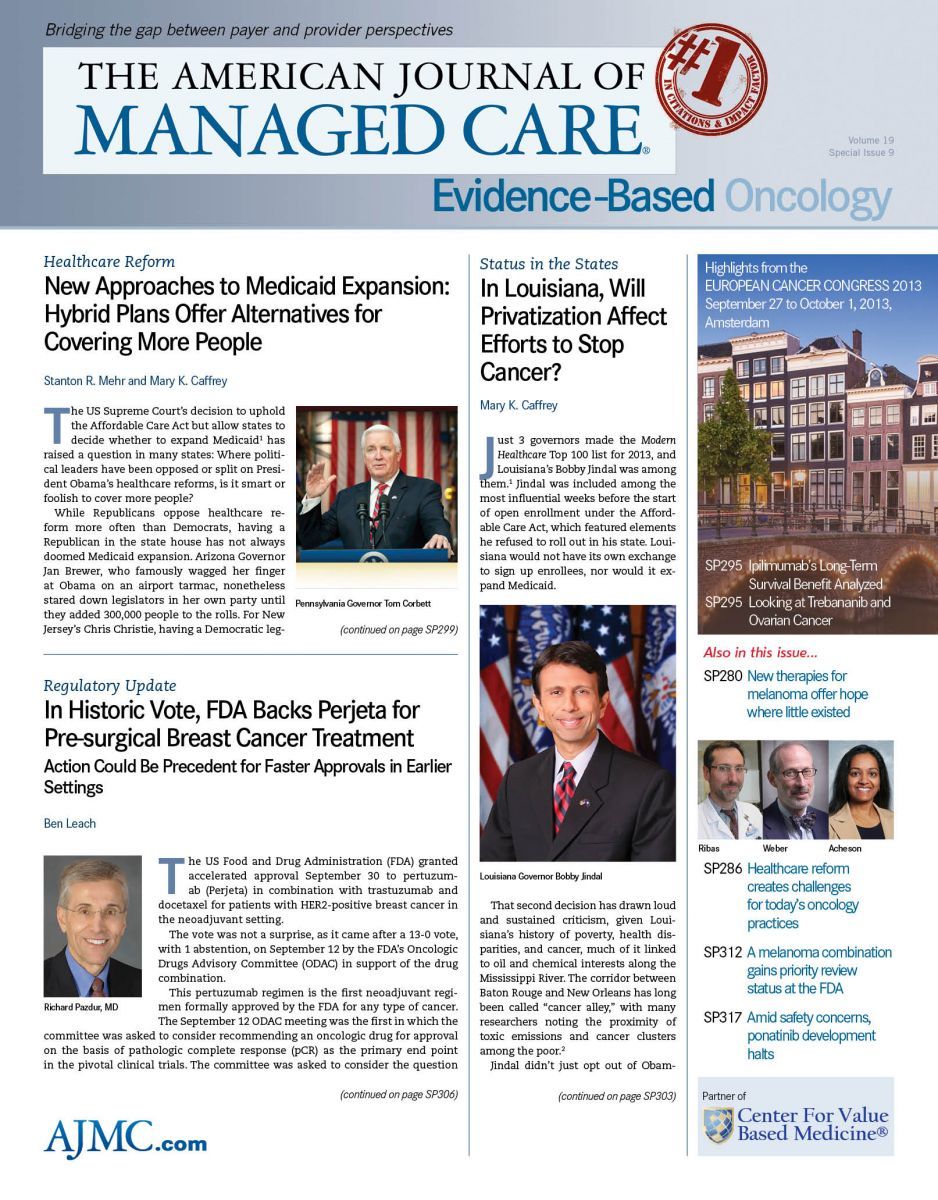- Center on Health Equity & Access
- Clinical
- Health Care Cost
- Health Care Delivery
- Insurance
- Policy
- Technology
- Value-Based Care
Dual HER2 Blockade Less Effective in PI3KCA-Mutant Breast Cancer
European Cancer Congress 2013
Breast cancer patients with PI3KCA mutations are less likely to achieve a pathological complete response (pCR) from dual HER2 blockade in the neoadjuvant setting, according to an analysis of the NEOALTTO trial presented by José Baselga, MD, at the 2013 European Cancer Congress.1
The lower pCR rate in PI3KCA-mutant tumors was observed in all treatment arms, irrespective of estrogen receptor (ER) status. “Understanding the mechanism of The pCR rate for the lapatanib arm was 20.4% for wild-type patients versus14.8% for those with PIK3CA mutations, and for the trastuzumab arm, the pCR rates were 28.4% and 20.0%, respectively.
“Understanding the mechanism of resistance to HER2-targeted agents is a critical step toward identifying the best therapy for individual patients with HER2-positive breast cancer. Activation of the PI3K/AKT survival pathway is one of the molecular mechanisms that contribute to trastuzumab resistance,” Baselga explained.
The study investigated the influence of PI3K pathway mutations (PIK3CA, KRAS, BRAF, AKT1) on sensitivity to trastuzumab (Herceptin), lapatinib (Tykerb), or both agents in combination in early-stage, HER2-positive breast cancer patients enrolled in the phase III NEOALTTO trial. In the main study, dual HER2 blockade achieved a pCR rate of 51.3%, versus 29.5% for trastuzumab alone, and 24.7% for lapatinib alone (P = .0001). The current analysis was based on molecular profiling of 355 NEOALTTO patients.
The primary end point was pCR at surgery, defined as the absence of tumor in the breast. ER-positive and ER-negative patients had similar rates of PIK3CA mutations, at 23% and 22%, respectively.By treatment assignment, PIK3CA mutations were observed in 23% of the lapatinib arm, 19% of the trastuzumab arm, and 25% of the combination arm. Mutations in KRAS were observed in 1 patient (0.3%), and no patient had a BRAF mutation.
PIK3CA mutations were associated with lower pCR rates, most notably in the lapatinib/trastuzumab arm, Baselga reported. For the entire cohort, the rate of pCR was 34% in PI3KCA wild-type tumors, and 21% in PI3KCA mutant tumors (P = .03). In patients treated with the combination, pCR was achieved by 55.8% in those lacking PIK3CA mutations and 28.6% in those patients with mutations (P = .02). The pCR rate for the lapatanib arm was 20.4% for wild-type patients versus 14.8% for those with PIK3CA mutations, and for the trastuzumab arm, the pCR rates were 28.4% and 20.0%, respectively.
A similar pattern was seen in both ER-negative and ER-positive patients. Adjusting for treatment arm and ER status in the logistic regression analysis, significant differences persisted between patients with and without the PIK3CA mutation (odds ratio = 0.45; P = .015). “These data provide further evidence of the role of PIK3CA mutations in resistance to trastuzumab- and lapatinibbased therapies. Thus, assessment of PIK3CA status might be an important tool in identifying patients unlikely to derive substantial benefit from these treatments,” Baselga said.Reference
1. Baselga J, Majewski I, Nuciforo PG, et al. PI3KCA mutations and correlation with pCR in the NeoALTTO trial (BIG 01-06). Presented at: European Cancer Congress 2013; September 27-October 1, 2013; Amsterdam, The Netherlands. Abstract 1859.

HEDIS Glycemic Goal Achieved Using Control-IQ Technology
December 22nd 2025A greater proportion of patients with type 1 diabetes who used automated insulin delivery systems vs multiple daily injections achieved the Healthcare Effectiveness Data and Information Set (HEDIS) glycemic measure.
Read More
Linking Data to Determine Risk for 30-Day Readmissions in Dementia
December 22nd 2025This study found that certain characteristics in linked electronic health record data across episodes of care can help identify patients with Alzheimer disease and related dementias at high risk of 30-day readmissions.
Read More
Performance of 2-Stage Health-Related Social Needs Screening Using Area-Level Measures
December 19th 2025Limiting health-related social needs screening to lower-income areas would reduce screening burdens; however, this study found a 2-stage screening approach based on geography to be suboptimal.
Read More
Impact of Medicaid Institution for Mental Diseases Exclusion on Serious Mental Illness Outcomes
December 17th 2025Medicaid’s Institution for Mental Diseases (IMD) rule bars federal funding for psychiatric facilities with more than 16 beds, but findings indicate that state waivers allowing treatment of serious mental illness in IMDs do not increase overall psychiatric hospitalizations.
Read More
Physician-Pharmacy Integration in Cancer Care: Pillars of Medically Integrated Pharmacy
December 16th 2025The foundation of medically integrated pharmacy includes 7 critical pillars. This commentary focuses on the benefits of 3 of those pillars: abandonment, adherence, and access/affordability.
Read More

